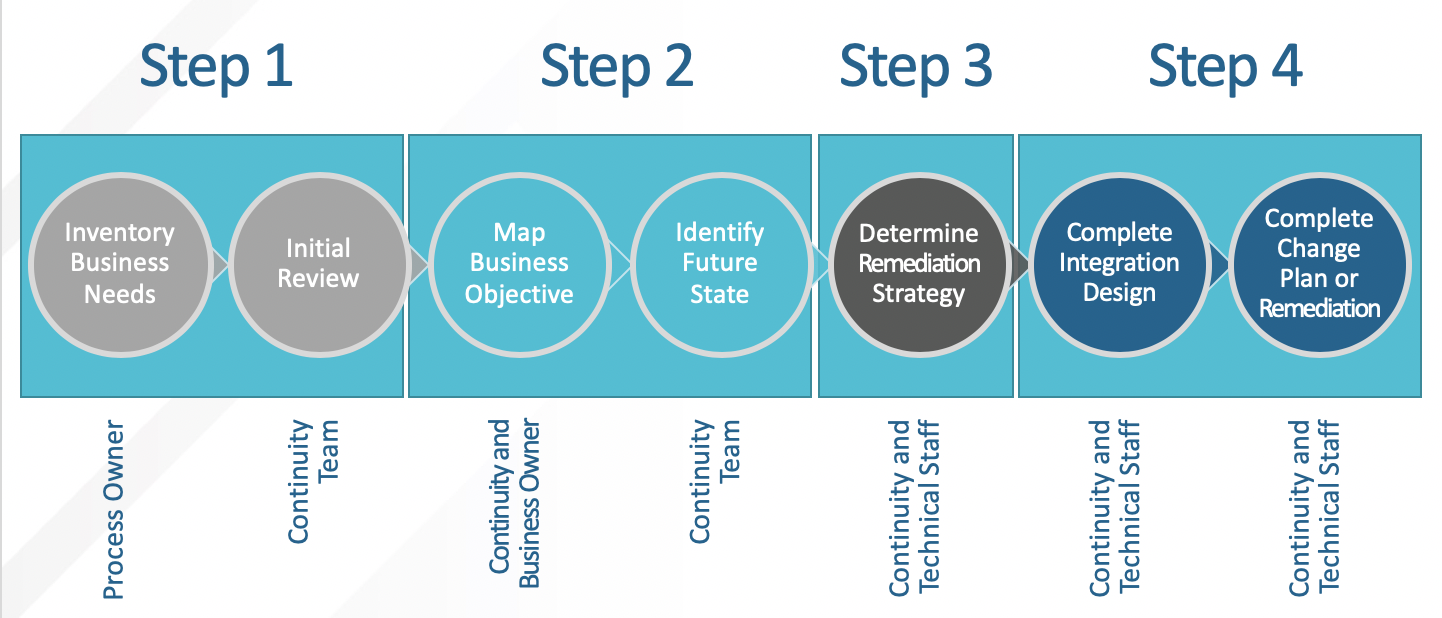ESR Continuity Planning
ESR is replacing campus-wide information systems like IFIS financial, ISIS student and PPS human resources and payroll. As new enterprise systems are put into place, business processes that interface with the current systems for reporting, analysis and data entry will need to change.
ESR Continuity Planning supports the continuation of local business operations as new systems come online and old systems are retired. The goal of Continuity Planning is to provide a smooth transition for business and process owners.
A Four-Step Process
A team of technical and functional experts works with owners of inventoried business processes to assess their business objectives and move toward the design and implementation of an appropriate data use solution.
Each business case will be individually reviewed through a 4-step process beginning with information collection through review and a solution. The steps in the Continuity process build on each other in the following order: 
Step 1: Data Use Inventory
Each current process or system that interfaces with or uses data from an enterprise system must be documented by the owner in the Data User Inventory.
An inventory consists of documentation of the process, the process workflow and types of data used as well as applications or software that supports the process.
How to start your inventory
First, check to see whether your business process or system may have already been entered in the Data Inventory Status report. (VPN or campus connection required.)
To document your process or system, go to the Data Use Inventory form. Instructions can be found on the form. Contact esr-continuity@ucsd.edu with questions.
When to Complete Your Inventory
The Data Use Inventory form will remain available throughout the duration of the ESR program, with reviews and additional calls for inventory taking place as needed.
Enterprise system projects may refer to the inventory at any time, so document your processes as soon as possible. Delaying documentation may lead to a delay in access to the new system's data.
Step 1 is completed when an inventory has been submitted and the Continiuty Planning team has collected all of the necessary information, including follow-up consultations.Step 2: Business Objective Mapping & Determination
The ESR Continuity Planning team works with business and process owners to align business objectives with one of two general transition pathways:
Meeting Needs Through a New Enterprise System
The modern and robust enterprise systems coming online are chosen specifically because they are a good fit for our most important business processes with the widest application possible.
In-system report generation, analytics tools, data entry and other functions included in the new systems are some of the ways that new enterprise systems such as Oracle Financial or Kuali Research meet business needs.
Enterprise data repositories, called Activity Hubs, can also fulfill the need for reporting and analysis of current and historical data from one or more enterprise systems.
Meeting Needs Through Integration
In some cases, a new enterprise system won’t fulfill the stated business objective, so local business systems and processes will need to be integrated with the new systems of record via Application Programming Interfaces (APIs).
Integration efforts require time and resources, and some may only proceed with approval from appropriate departmental or divisional leadership.
Step 2 is complete when ESR and the business owner have entered into a formal agreement specifying the transition to be applied. The business process may then move on to Step 3.
Step 3: Integration Strategy
With a transition path identified, Step 3 covers planning how it will happen. Planning the integration strategy will consider:
- Life expectancy of the Integrated solution – priority is given to solving for the long term rather than applying a quick fix that will eventually need replacing, which will incur additional technical debt, throw-away work and additional workarounds.
- Available resources, including personnel, that will be needed to execute the strategy within a desirable timeframe.
- When, or whether, the new enterprise system will address the business objective.
- Constraints imposed by vended solutions.
The planning step will be a careful balance of these factors. The overriding objective is to identify a long-term solution, however, circumstances may dictate and necessitate a sub-optimal solution.
Departmental and divisional leadership will need to be included in, and supportive of, the identified strategy.
At the conclusion of this step, the business owner and ESR team will have a detailed plan in place.
Step 4: Execution and Support
With the strategy agreed upon and plan in place, Step 4 is where the work is completed. ESR Continuity Planning, business owners, subject matter experts and technical personnel will all be involved in the execution of the transition plan.
Business owners and teams of business processes that have progressed to Step 4 will have exclusive access to transition team office hours, published notes and reference materials, an online question and answer forum and other resources to assist them.
Note that Step 4 may be an iterative process. For a variety of reasons, an interim solution may be required to ensure business process continuity, and the business owner will be expected to continue work with ESR Continuity Planning on implementation of the long-term solution.Reporting
Transparency is a key component of the ESR Continuity Planning process. The Continuity Planning team tracks the status of each inventoried item, and all can be viewed in this report. (VPN or campus connection required.)
Subscribe to ESR project newsletters for ongoing news and updates.
What Comes Next
If you have not started your inventory, do that now.
After you have created an inventory, you will be contacted by the ESR Continuity Planning team and enterprise system project teams as they review system-related business processes.